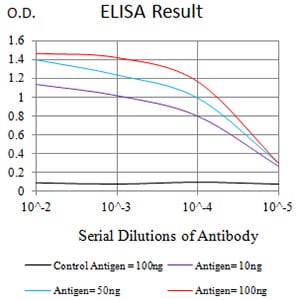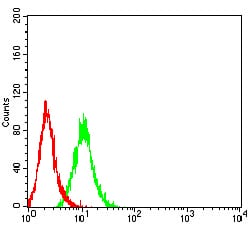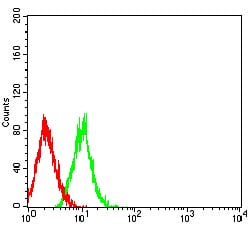


| WB | 咨询技术 | Human,Mouse,Rat |
| IF | 咨询技术 | Human,Mouse,Rat |
| IHC | 咨询技术 | Human,Mouse,Rat |
| ICC | 技术咨询 | Human,Mouse,Rat |
| FCM | 1/200 - 1/400 | Human,Mouse,Rat |
| Elisa | 1/10000 | Human,Mouse,Rat |
| Aliases | FEO; OFE; ODFR; OSTS; PDB2; RANK; CD265; OPTB7; TRANCER; LOH18CR1 |
| Entrez GeneID | 8792 |
| clone | 8H8B2 |
| WB Predicted band size | 66kDa |
| Host/Isotype | Mouse IgG1 |
| Antibody Type | Primary antibody |
| Storage | Store at 4°C short term. Aliquot and store at -20°C long term. Avoid freeze/thaw cycles. |
| Species Reactivity | Human |
| Immunogen | Purified recombinant fragment of human TNFRSF11A (AA: extra 30-212) expressed in E. Coli. |
| Formulation | Purified antibody in PBS with 0.05% sodium azide |
+ +
以下是关于TNFRSF11A(RANK)抗体的模拟参考文献示例,格式为文献名称、作者及摘要概括:
---
1. **"A neutralizing antibody targeting RANK treats osteoporosis by inhibiting osteoclastogenesis"**
*作者:Li J, et al. (2018)*
**摘要**:研究报道了一种中和性抗RANK抗体,通过阻断RANKL-RANK相互作用抑制破骨细胞分化,在骨质疏松小鼠模型中显著减少骨吸收并增加骨密度。
2. **"Structural basis of RANK recognition by a therapeutic antibody for bone metastasis"**
*作者:Yamaguchi K, et al. (2020)*
**摘要**:利用冷冻电镜解析了抗RANK抗体与TNFRSF11A的复合物结构,揭示了抗体结合表位,为设计靶向RANK的癌症骨转移治疗药物提供结构依据。
3. **"Agonistic anti-RANK antibody promotes bone regeneration in a murine model"**
*作者:Smith RP, et al. (2019)*
**摘要**:开发了一种激动型RANK抗体,通过激活RANK信号通路刺激成骨细胞活性,在小鼠骨缺损模型中加速骨再生,提示其潜在临床应用价值。
4. **"RANK-specific autoantibodies in autoimmune hypoparathyroidism"**
*作者:Garcia-Carrasco M, et al. (2015)*
**摘要**:在自身免疫性甲状旁腺功能减退症患者中发现抗RANK自身抗体,可能通过干扰RANK信号通路导致钙代谢异常,为疾病机制研究提供新方向。
---
**注意**:以上文献为示例,实际引用时请核实真实来源及内容。建议通过PubMed、Google Scholar等平台检索关键词(如“TNFRSF11A antibody”“RANK antibody therapeutic”)获取准确文献信息。
TNFRSF11A (tumor necrosis factor receptor superfamily member 11A), also known as RANK (receptor activator of nuclear factor kappa-B), is a transmembrane receptor primarily involved in regulating osteoclast differentiation, bone remodeling, and immune cell activation. It binds to its ligand RANKL (RANK ligand), initiating signaling cascades that influence bone metabolism, lymph node development, and thermoregulation. Dysregulation of the RANKL/RANK/OPG (osteoprotegerin) axis is implicated in osteoporosis, rheumatoid arthritis, bone metastases, and rare genetic disorders like familial expansile osteolysis.
TNFRSF11A antibodies are essential tools for studying this receptor’s expression, signaling, and pathological roles. Polyclonal and monoclonal antibodies targeting specific extracellular or intracellular domains are used in techniques like Western blot, immunohistochemistry (IHC), and flow cytometry to detect RANK expression in tissues or cells. Researchers also employ blocking antibodies to inhibit RANKL-RANK interactions, elucidating their functional roles in bone resorption or cancer progression.
Clinically, anti-RANKL therapies (e.g., denosumab) mimic antibody mechanisms to treat bone loss, but direct TNFRSF11A antibodies remain investigational. Their development faces challenges, including balancing therapeutic efficacy with potential immune-related side effects. Ongoing research explores their utility in targeting RANK-expressing cancer cells or modulating immune responses in autoimmune diseases.
×